Temperature, watering, feeding, and, in the end, patience are the keys to growing flavorful peppers. If you lack one of these, your peppers will be less tasty than they could be.
From the beginning of the season through harvest, you can grow more flavorful peppers if you give peppers what they need.
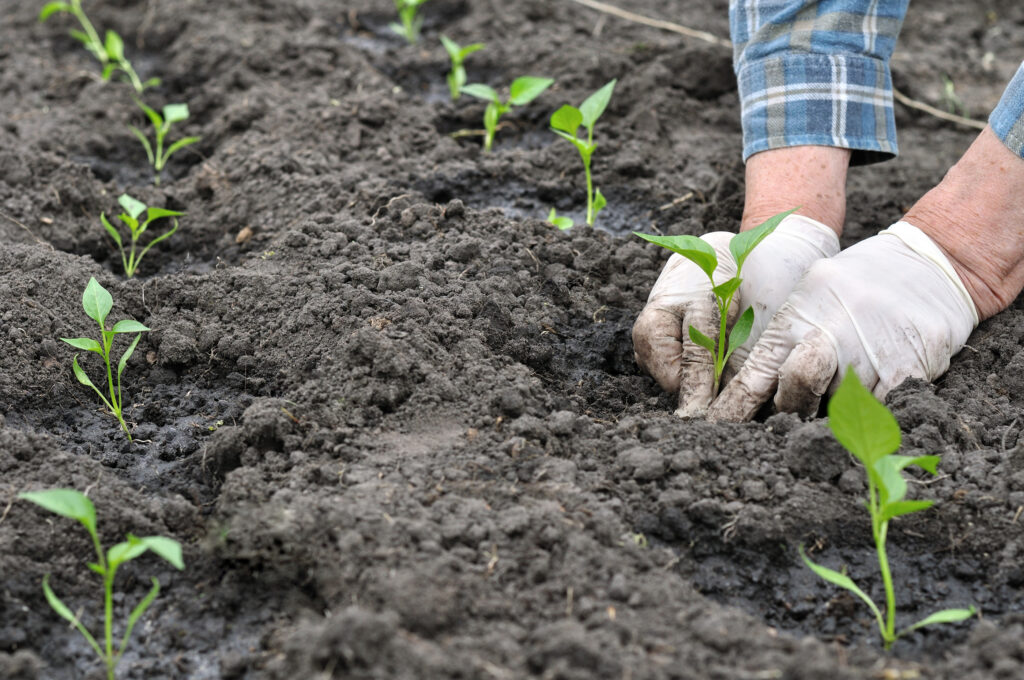
Here are six easy-to-follow tips to grow flavorful peppers:
Tip #1: Temperature helps determine pepper flavor
- Peppers demand warm temperatures: don’t put peppers in the garden until the soil temperature is 70°F (24°C). Use black plastic to warm the soil in advance of planting or plant peppers in raised beds which warm quickly in spring.
- Peppers grow best when night temperatures are between 60° and 70°F (16° to 24°C) and daytime temperatures average 75°F.
- When night temperatures are consistently warmer than 70°F, pepper plants drop their flowers and fruit buds. Peppers stop producing during the hottest time of the summer—when nighttime temperatures top 70°F (32°C). When peppers drop their flowers or fruit don’t pull them up; they will rest until the weather cools and then begin producing again.
- In hot regions, plant peppers so they flower and set fruit before night temperatures reach 70°F; plant a second crop after the peak of summer heat when nighttime temperatures are cooler.
- Protect peppers with shade cloth or overhead irrigation when temperatures get too hot. Use white spun poly row covers spread over hoops above pepper plants–leave the sides open for ventilation–to protect peppers from sunscald and high temperatures. When the temperatures soar, overhead irrigation can reduce the temperature in the garden slightly.
Best growing tips: How to Plant, Grow, and Harvest Peppers.
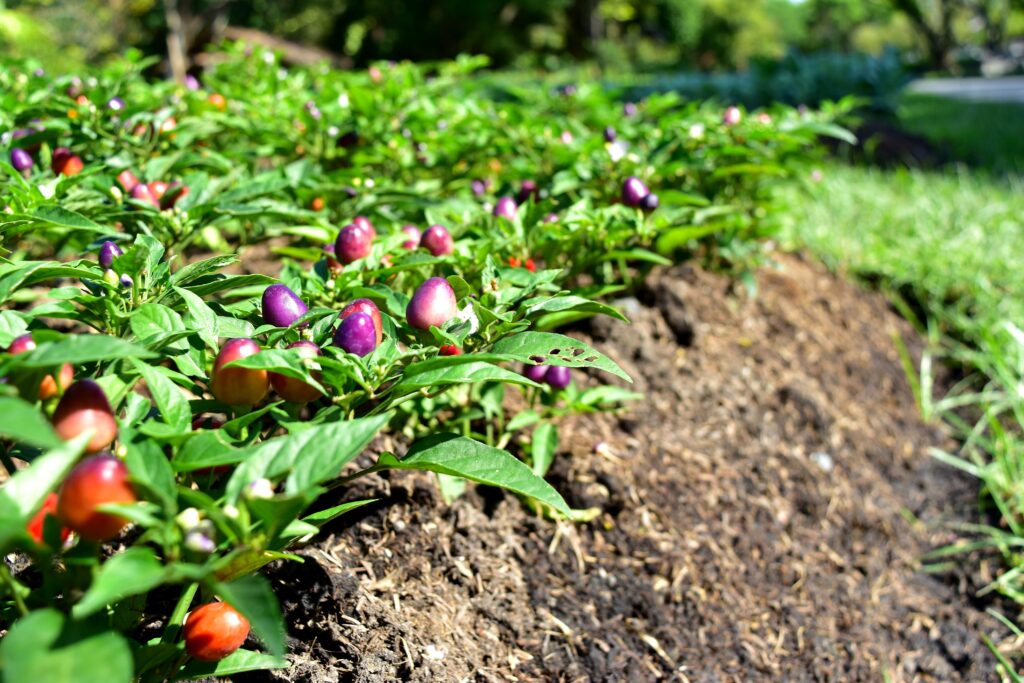
Tip #2: Soil and sun affect pepper flavor
- Peppers grow best in full sun; however, they do not perform well if there is too much sun. If you live in a very hot summer location, plan to shade peppers from sunscald in the hottest part of the summer, or plant peppers where they get only morning sun that is less likely to burn fruit. If you live in a cool summer location, plant peppers in a south-facing location or against a fence or building that soaks up the solar heat and radiates heat into the garden at night.
- Peppers grow best in slightly acidic, well-drained soil. Add organic compost to the planting bed in advance of planting; but, peppers will grow in sandy or gravelly loam as well. Soil can affect pepper flavor; hot peppers grown in poor soil in a hot, dry climate will be hotter than the identical variety grown in rich soil in a cooler summer region. Sweet peppers grow sweeter when the soil is sweet—that is compost rich, not alkaline.
- Dust the planting bed with a fine layer of Epsom salts before planting peppers or add a half handful of Epsom salts to the bottom of each planting hole. Epsom salts contain magnesium which peppers need for fruit development.
- Plant peppers 20 inches apart—not closer. This will give each plant ample room to develop more branches which in turn will produce more fruit. The extra space will also allow for more even ripening of fruit.
Good Products for Raised Bed Growing at Amazon:
- Galvanized Raised Bed 8×3
- Cedar Raised Bed 4×8
- Elevated Cedar Planter 4×2
- Walk-In Greenhouse Tunnel 15x7x7
- Row Cover for Freeze Protection 10×30
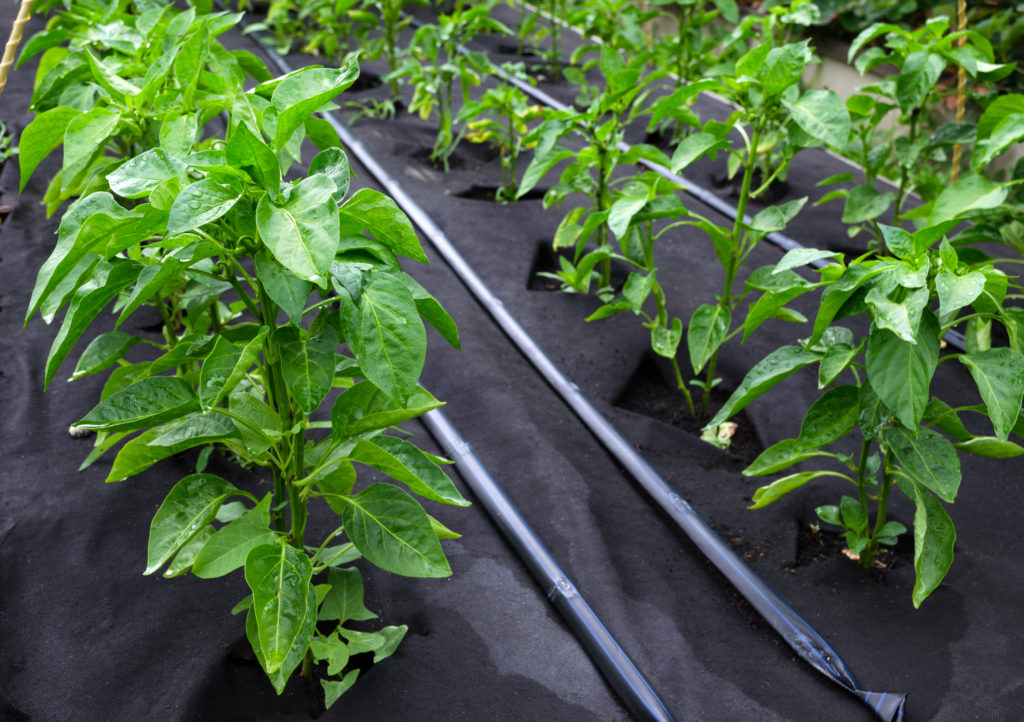
Tip #3: Watering boosts pepper flavor
- Keep the soil around peppers evenly moist for best fruit development.
- Young peppers putting down roots need at least 2 inches of water each week–that is a bit more than one gallon per square foot per week. Once peppers flower and begin to fruit give each plant an inch of water every week—that is a bit more than a half-gallon of water for each square foot of planting area. When fruits reach maturity—full size—but are still ripening they will need water only when the soil is dry. Less water once fruits mature will allow peppers to ripen to full color more quickly.
- Hot peppers can be made even hotter if you flood the roots just before harvest; water stress causes plants to produce more heat.
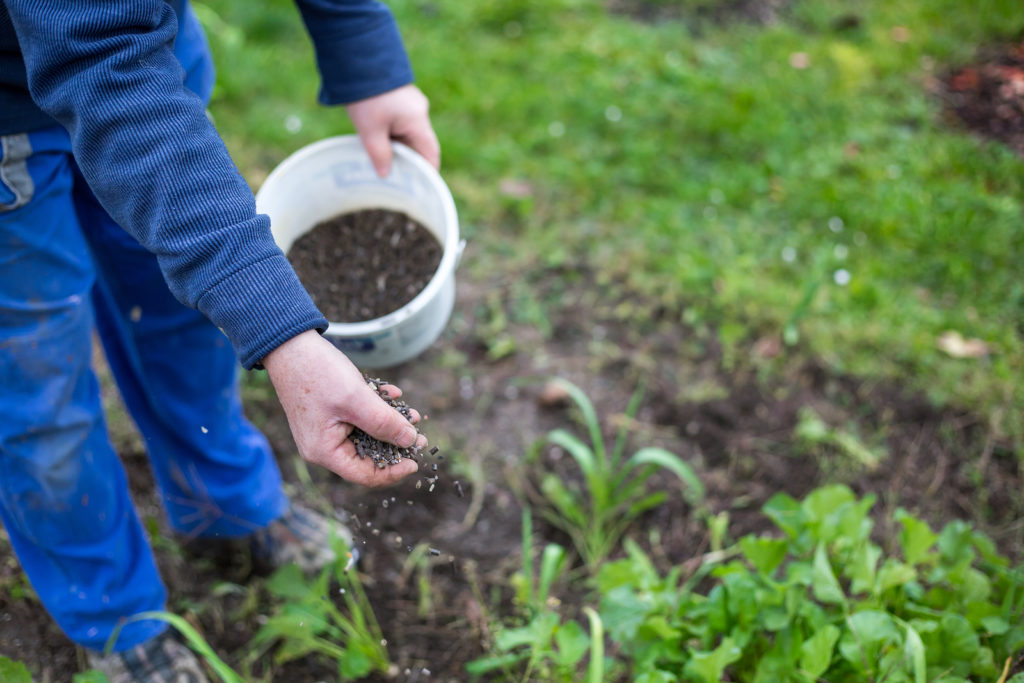
Tip# 4:Feed peppers for flavor
- Feed peppers after the first flowers appear for best fruit development; feeding peppers before flowering can prompt green growth, not fruit growth—so wait for flowering to feed. Place a side-dressing of aged compost around pepper plants when the first flowers open, or feed plants with a liquid kelp meal mixture or compost tea. Feed them again three weeks later.
- A granular time-release fertilizer can be spread around peppers to feed for two months during he growing season.
- Epsom salts help peppers develop faster and stronger; dissolve 3 tablespoons of Epsom salts in warm water and give each plant a pint when they begin to bloom. Or spray leaves with a solution of 1 teaspoon of Epsom salts to a pint of lukewarm water. (Magnesium deficiency can cause blossom drop and leaf edges to turn yellow, then brown.)
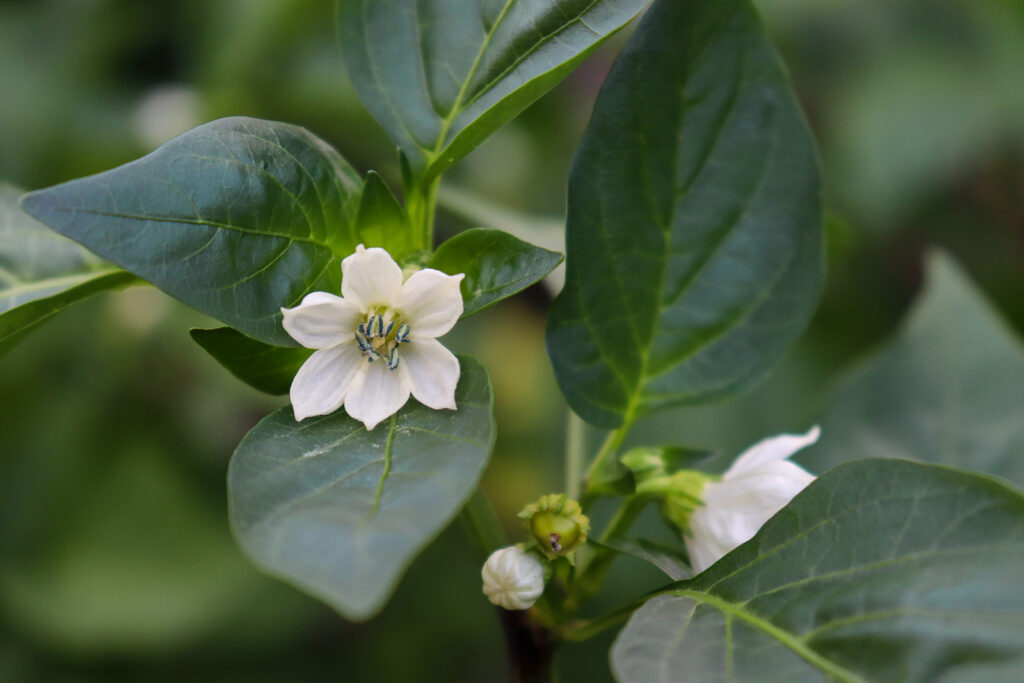
Tip #5: Pepper flowers and flavor
- Nip off the first flower buds that appear on peppers. This will allow plants to mature and direct their energy to strong roots and branch development before fruiting. A plant with strong roots and branches will bear more fruit and hold fruit until ripeness.
- Peppers are pollinated by insects; peppers easily cross-pollinate which can affect fruit development and flavor. Keep hot peppers and sweet peppers well separated–900 feet between varieties is optimal, or stagger planting so that different varieties are not flowering at the same time.
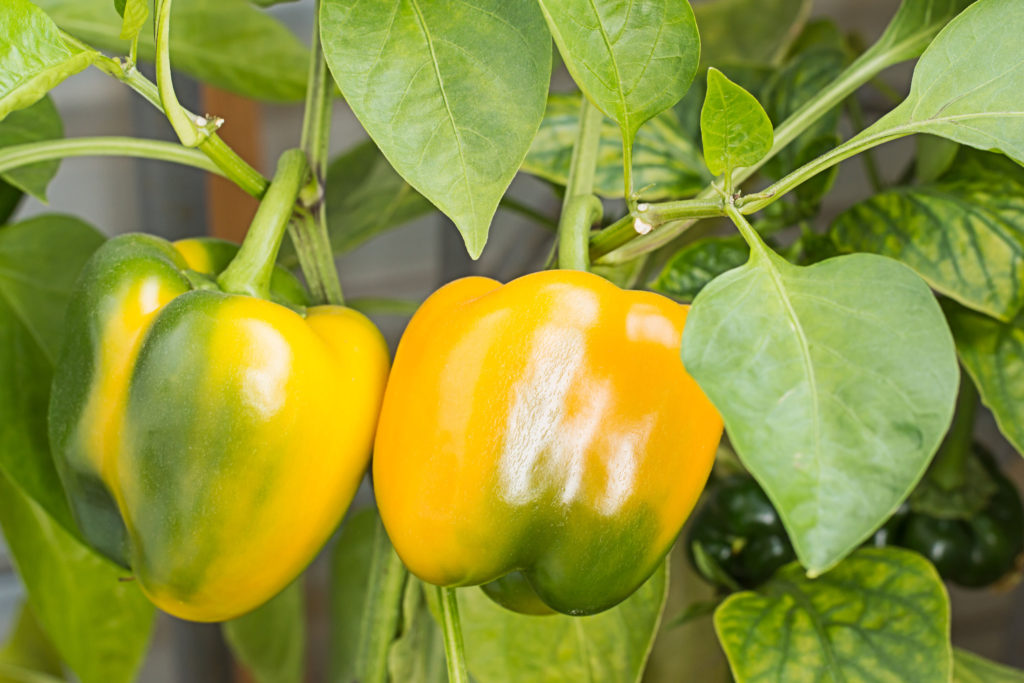
Tip #6: Ripening peppers for flavor and harvest
- Peppers–both sweet and hot–require at least 70 days from transplanting to maturity. Once the fruit is full size it can take another one to three or four weeks for the fruit to ripen to full flavor. Let peppers ripen on the plant. The hotter the pepper the longer it takes to mature—the very hottest peppers take from 90 to 200 frost-free days to ripen.
- Peppers stay green until they reach their mature size; if left on the plant they will then ripen to a bright red, orange, or yellow depending upon the variety—and they will gain in flavor becoming much sweeter or hotter depending upon the variety.
- For the very best flavor, allow each fruit to completely change colors before you pick the fruit. When it is time to harvest, lift the fruit and then snip it away from the branch with a pruner; that way you will not break branches and hinder future fruiting.
- If your season is long enough, you can modestly prune pepper plants back after harvest and a second crop will follow. Be sure to water and feed plants the second time around just as you did the first.
Flavorful pepper varieties to grow
Sweet peppers
- Bell Boy. 70 days. Meaty, sweet pepper. Large, blocky fruit, 4½ inches square; thick-walled, mostly 4-lobed; fruits turn from green to red. Sturdy compact plant Early yields. All-American selection; resistant to most diseases. Hybrid
- California Wonder. 68-89 days. Tender, juicy sweet with no hint of pungency. Smooth, blocky, 3 to 4-lobed fruit with glossy, 4½ inches long by 4 inches in diameter, dark-green skin; thick-walled to ⅜ inches; ripens to bright crimson. Vigorous, upright plant 24 to 30 inches tall. Good leaf cover. Tobacco mosaic virus resistant. Open-pollinated
- Corno di Toro (also called Yellow Bull’s Horn). 68-70 days. Spicy flavor, neither hot nor very sweet. Fruit 8 inches long, 1½ inches in diameter at the shoulder; tapered to a curved point, resembling the horn of a bull. Ripens to a deep golden yellow or deep red depending upon the cultivar. Traditional Italian favorite. Open-pollinated.
- Early Pimento. 60 days. Heart-shaped fruit turns from green to red. Use fresh or for pickling or canning. Heavy early yields. A good choice for a home garden. All-America Selection; resistant to most diseases. Hybrid
- Golden Bell. 70 days. Very sweet. Medium-large blocky 3 to 4-lobed fruit; light green turning bright yellow-gold at maturity; thick-walled. Vigorous upright plant to 21 inches tall. Leaves provide good cover for fruit. Adapted mainly for home garden use. Hybrid.
- Golden Summer Hybrid. 70 days. Juicy sweet; great overall flavor. Large blocky 3 to 4-lobed fruit; pale lime-green ripening to golden yellow; thick-walled. Does not ripen yellow in short-season areas. Upright plant 24 to 28 inches tall. Good fruit set; wide adaptability. Tobacco mosaic virus resistant. Hybrid.
- Gypsy. 65 days. Sweet, tender, and crisp; excellent flavor and quality. Wedge-shaped, slightly curved fruit 3 to 4 inches long; yellow, ripening to orange-red; medium thin walls. Vigorous spreading plant, 12 to 20 inches tall. Widely adapted. All-America Selection. Tobacco mosaic virus resistant. Hybrid.
- Jupiter. 66-72 days. Sweet. Large, blocky 4 lobed fruit; 4½ inches tall by 4½ inches wide; green turning bright red when ripe; thick-walled. Vigorous high yield widely adapted plants to 30 inches tall; the dense canopy of leaves provides fruit protection from sunburn. Tobacco mosaic virus resistant. One of the best open-pollinated cultivars.
- Keystone Resistant Giant. 72-80 days. Sweet and mild. Large blocky mostly 4-lobed fruit 4½ inches long 3¾ inches in diameter; attractive thick, dark-green skin, turning dark red when ripe; thick-walled. High-yielding plant; ever-bearing, 30 to 38 inches tall with large dark-green leaves. Performs well in short summer regions. Tobacco mosaic virus resistant. Open-pollinated.
- Nardello. 65-75 days. Extremely sweet smoky-flavored Italian frying pepper. Slender, tapered 7 to 8 inches long, 1 inch wide; green turning red when ripe; thin-walled. Excellent for frying or eating raw, also freezing and drying. Medium-tall, heavy-yielding plant. Open-pollinated.
- Sweet Banana. 70 days. Sweet and mild. Cylindrical fruit, tapering to a point, 6 inches long, 1½ inches in diameter; waxy yellow, turning red when ripe; medium thick-walled. Compact, sturdy plants 18 to 22 inches tall; produce an abundance of fruit over a long period. All-purpose use. All-America Selection; resists most diseases. Open-pollinated.
- Sweet Yellow or Cubanelle. 62-70 days. Sweet to spicy-flavored frying pepper. Tapering fruit with a blunt end, 5 to 6 inches long, 2 to 2½ inches across, 2 to 3 lobed; yellow-green turning red-orange skin when ripe, medium thick wall. Bushy 28 to 30-inch tall plant. Heavy yield setting fruit continuously. Open-pollinated.
- Yolo Wonder. 70-80 days. Thick, juicy sweet; improved California Wonder. Blocky 3 to 4-lobed fruit, 5 inches long by 4½ inches in diameter; attractive green, ripening to red skin. Bushy plant, 24 to 28 inches tall and spreading. Leaves offer fruit good protection from sunscald and hail. Tolerant of adverse weather conditions. Tobacco mosaic virus resistant. Open-pollinated.
Hot peppers
- Anaheim. 70-90 days. Medium-hot chili. Tapered to a point fruit, 7 to 8 inches long, 1½ inches wide; fruit light to dark green turning crimson red when ripe; medium thick-walled. Use for stuffing when red ripe, also for canning, drying, and frying. Vigorous upright plant, 28 to 30 inches tall. Widely grown in California and Southwest.
- Anaheim TMR 23. 74-80 days. Moderately hot. Fruit is tapered, 7 to 8 inches long, 2 inches wide; deep-green maturing to red. Freeze, dry, or can. Late-maturing variety; sturdy erect 24 to 34 inches tall; planted extensively in the South, California, and Mexico. Tobacco mosaic virus resistant. Hybrid.
- Cayenne Long Slim. 70-75 days. Very hot. Slender fruit, tapered to a point, often wrinkled, 6 to 7 inches long, ½ inch wide; dark green ripening to bright red. Excellent for drying, pickles, and canning. Vigorous, high-yielding plant; 20 to 24 inches tall. Well-known, popular variety. Open-pollinated.
- Hungarian Yellow Wax. 58-85 days. Medium hot. Uniform, slightly tapered fruit 6 to 7 inches long, 1½ inches in diameter; waxy yellow turning red at maturity; firm, medium-thick walled. Upright plant 16 to 24 inches tall. Sets fruit continuously. Grows well in cool regions. Good for pickling and canning. Open-pollinated.
- Jalapeño. 65-80 days. Very hot. Sausage-shaped fruit tapering to a blunt end, about 3 inches long and 1 to 1½ inches in diameter; fruit is glossy deep-green turning bright red when ripe; medium thick wall. Common and popular variety widely used in Mexican and Southwestern cuisine. The Dark-green plant is 26 to 26 inches tall; its leaves provide a good fruit cover. Very productive. Open-pollinated.
- Serrano Chili Pepper. 75-90 days. Very hot; Tabasco-type pepper. Slender, cylindrical fruit tapering to a blunt point, 2¼ inches long, ½ inch in diameter; medium dark-green ripening to bright red; medium thin walls. Vigorous, highly productive plant, 30 to 36 inches tall. Use for pickling or sauce. Popular in Mexico and the Southwest. Open-pollinated.
- Tam Mild Jalapeño. 67-73 days. Mild heat with jalapeno flavor and aroma. Compact dark-green plant, 24 to 30 inches tall. Excellent producer. Good for eating raw, roasted, and pickling. Potato virus Y resistant. Hybrid.
More pepper growing success tips
Pepper success growing tips:
Start seeds indoors
Sow pepper seeds indoors 8 to 12 weeks before setting them in the garden. Peppers need a very warm start to life, 80°F soil temperature for germination and 80°F daytime temperature, and 75°F nighttime temperature for growing on to transplant size. Keep seedlings evenly moist with lukewarm water in the early stages of growth.
Transplant after the last frost
Transplant peppers to the garden when all danger of frost is well past and the soil has warmed to at least 65°F and nighttime air temperatures do not dip below 50°F. Use black plastic to prewarm the soil before transplanting. Plant peppers in full sun in well-drained soil–raised beds are best. Add aged compost and a sprinkle of bonemeal to each planting hole. In short or cool season regions, grow quick-maturing varieties or varieties adapted to cool temperatures.
Care through the season
Keep peppers evenly moist but don’t overwater. As the peppers ripen, cut back on watering to enhance flavor. Side-dress peppers with aged compost during the growing season. Support peppers with stakes or cages so that they do not lean or snap as the fruit matures. Each fruit should be shaded by leaves above to avoid sunburn. If temperatures threaten to dip below 55°F, have row covers ready to protect plants and fruits.
Protect peppers from too much heat
Peppers do not do well when air temperatures exceed 90°F; blossoms will drop and fruit may be sunburned. Protect peppers with shade cloth or plan ahead and plant them between rows of taller tomatoes or pole beans. Add organic mulch to keep the soil from overheating.
Harvest at the right time
Sweet bell peppers can be harvested at an edible size before they turn full color; you can allow them to complete ripening on the kitchen counter. Picking peppers will encourage more fruit to set. Hot peppers are best harvested when fully colored. Complete the pepper harvest before the first frost in autumn.
Pepper articles at Harvest to Table:
How to Grow Sweet Bell Peppers
How to Plant and Grow Hot Chili Peppers
Six Tips to Grow Peppers for Flavor
7 Tips for Growing Peppers in Pots
How to Harvest and Store Peppers
Five Ways to Cook and Serve Sweet Peppers
Five Ways to Cook and Serve Chili Peppers
Beginner’s Guide to Canning Peppers
Pepper Growing Problems Troubleshooting
Mid-Season Pepper Problems Cures
Epsom Salt, Milk, and Organic Fertilizers for Tomatoes and Peppers
How to Prevent Blossom Drop — Tomatoes and Peppers
Garden Planning Books at Amazon:
- Tomato Grower’s Answer Book
- Vegetable Garden Almanac & Planner
- Kitchen Garden Grower’s Guide Vegetable Encyclopedia
- Vegetable Garden Grower’s Guide















